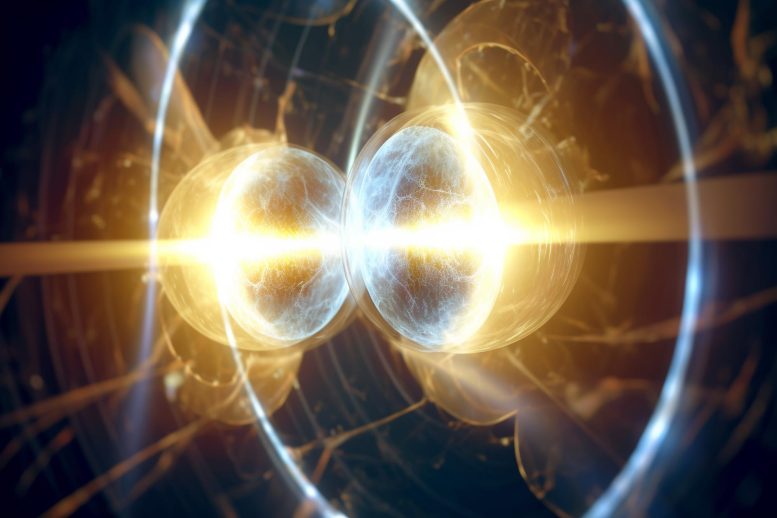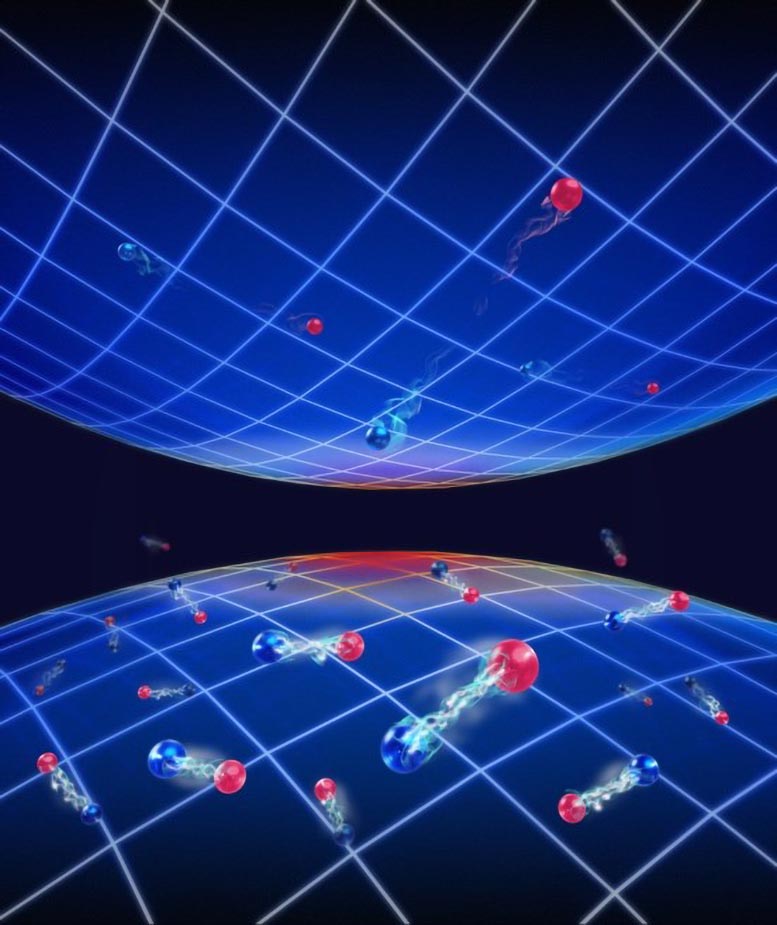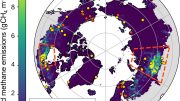
Researchers have made a landmark discovery in quantum physics by observing and quantitatively characterizing the many-body pairing pseudogap in unitary Fermi gases, a topic of debate for nearly two decades. This finding not only resolves long-standing questions about the nature of the pseudogap in these gases but also suggests a potential link to the pseudogap observed in high-temperature superconductors. Credit: SciTechDaily.com
Researchers have conclusively observed the many-body pairing pseudogap in unitary Fermi gases, advancing our understanding of superconductivity mechanisms.
A research team led by Professors Jianwei Pan, Xingcan Yao, and Yu’ao Chen from the University of Science and Technology of China (USTC) of the Chinese Academy of Sciences, has for the first time observed and quantitatively characterized the many-body pairing pseudogap in unitary Fermi gases.
This achievement, pursued by the ultracold atomic community for nearly two decades, resolves longstanding debates regarding the existence of a pairing pseudogap in these gases. It also supports pairing as a possible origin of the pseudogap in high-temperature superconductors, within the framework of preformed-pair superconductivity theory.
Published in Nature on February 7, this study coincides with the upcoming Year of the Dragon. Interestingly, the physics behind this achievement can be vividly illustrated by the iconic Chinese myth of “Carp Jumping Over the Dragon Gate,” symbolizing great success in Chinese culture.

In this artistic representation, two carp, each clasping a jade bead in its mouth, symbolize fermions with opposite spins. The Dragon Gate represents both the superfluid transition and the pseudogap. The depiction of the carp leaping over the Dragon Gate suggests the pairing above the superfluid phase transition temperature. This pairing phenomenon, in turn, leads to the appearance of the pseudogap. Credit: Lei Chen
Unraveling the Mysteries of Superconductivity
The existence of an energy gap is a hallmark phenomenon of superconductivity. In conventional superconductors, the energy gap exists below the superconducting transition temperature (Tc). Remarkably, in cuprate high-temperature superconductors, the energy gap can still be observed even above Tc, a phenomenon known as the pseudogap.
Understanding the origin and nature of the pseudogap is crucial for grasping the mechanism of high-temperature superconductivity, particularly regarding how Cooper pairs form and establish long-range phase coherence.
There are two main hypotheses for the pseudogap’s origin: It results from strong pair fluctuations, manifesting as preformed electron pairs above Tc and serving as a precursor to coherent pair condensation; and it arises from various quantum orders in high-temperature superconductors, such as the antiferromagnetic order, stripe phase, and pair density wave. Yet the complexity of high-temperature superconducting materials leaves these questions largely unanswered.

Red and blue spheres symbolize fermionic atoms with up and down spins, respectively. The curved surfaces with grids represent the momentum-energy landscapes for quasi-particles. Paired fermions inhabit the lower surface while unpaired fermions occupy the upper surface. The gap between the surfaces signifies the pseudogap, indicating that a minimal amount of energy is required to break the fermion pairs. Blurred fermion pairs in the gap suggest a partial filling of the pseudogap. Credit: Lei Chen
Quantum Simulation Sheds New Light
Unitary Fermi gases provide an ideal quantum simulation platform for investigating the existence and characteristics of a pairing pseudogap. This may be attributed to their unprecedented controllability, purity, and, most importantly, the presence of known short-range attractive interactions.
Additionally, the absence of a lattice structure in bulk Fermi gases eliminates the influence of competing quantum orders. In this context, previous experiments have measured the trap-averaged single-particle spectral function of strongly interacting Fermi gases.
However, these experiments have not provided convincing evidence of a pseudogap, primarily due to the inhomogeneity of the trap and serious issues arising from final-state interactions in the commonly used rf spectroscopy.
After years of dedicated work, the USTC research team has established a quantum simulation platform using ultracold lithium and dysprosium atoms, and has achieved a state-of-the-art preparation of homogeneous Fermi gases (Science).
Additionally, this team developed novel techniques to stabilize the required magnetic fields. At a magnetic field of approximately 700 G, the short-term fluctuations achieved are below 25 μG, resulting in a record-high relative magnetic field stability. This ultra-stable magnetic field enabled the research team to use microwave pulses to excite atoms to high-lying energy states that do not interact with the initial states, thereby realizing momentum-resolved photoemission spectroscopy.
With these two crucial technical breakthroughs, the research team systematically measured the single-particle spectral function of unitary Fermi gases at different temperatures and observed the existence of the pairing pseudogap, lending support for the role of preformed pairing as a precursor to superfluidity.
Furthermore, the research team determined the pairing gap, pair lifetime, and single-particle scattering rate from the measured spectral function, which are essential quantities for characterizing the behavior of strongly interacting quantum systems. These findings not only advance the study of strongly correlated systems, but also provide valuable insights and information for establishing a proper many-body theory.
The techniques developed in this work lay the foundation for future exploration and study of other important low-temperature quantum phases, such as single-band superfluidity, stripe phases, and Fulde–Ferrell–Larkin–Ovchinnikov superfluidity.
Reference: “Observation and quantification of the pseudogap in unitary Fermi gases” by Xi Li, Shuai Wang, Xiang Luo, Yu-Yang Zhou, Ke Xie, Hong-Chi Shen, Yu-Zhao Nie, Qijin Chen, Hui Hu, Yu-Ao Chen, Xing-Can Yao and Jian-Wei Pan, 7 February 2024, Nature.
DOI: 10.1038/s41586-023-06964-y









The existence of an energy gap is a hallmark phenomenon of superconductivity. Is the formation of energy gaps related to the left and right rotation of topological vortices? How to use energy gaps to understand quantum and superconductivity?
Science must follow mathematical rules. For example, the Standard Model (SM) is considered to be one of the most significant achievements of physics in the 20th century. However, the magnetic moment of μ particle is larger than expected, revealed by a g-2 experiment at Fermilab, suggests that the established theory (such as SM) of fundamental particles is incomplete. Furthermore, the SM omitting gravity, it not involved the time problem and when the particle movement starts. Mathematics is the foundation of science. Physics must respect the scientific nature of mathematics and mathematical models. The SM must be based on mathematical models in order to be scientific, convincing, and in line with natural laws.
I hope researchers are not fooled by the pseudoscientific theories of the Physical Review Letters (PRL), and hope more people dare to stand up and fight against rampant pseudoscience.
The so-called academic journals (such as Physical Review Letters, Nature, Science, etc.) firmly believe that two high-dimensional spacetime objects (such as two sets of cobalt-60) rotating in opposite directions can be transformed into two objects that mirror each other, is a typical case of pseudoscience rampant.
If researchers are really interested in Science and Physics, you can browse https://zhuanlan.zhihu.com/p/643404671 and https://zhuanlan.zhihu.com/p/595280873.
Been wondering lately if pairing moderates electron charge to some extent. It’s not a conventional idea, also probably not a new one. It stems from the notion that either magnetism or charge effects are fully detectable at any one moment, but not both together, and pairing may be, to some degree, a functional self-detection of magnetism. A little wild guesswork in there, maybe.
Net-neutral electron-hole pairs (excitons) are possible in graphite, seems likely Cooper pairs may be encouraged by cold excitons more than from any other localized transient lattice electron responses.
Even in a beam of electrons, formation of self-orienting, self-shielding dipoles in a series with spin-up alternating with spin-down should be likely, but this is easily overlooked in double-slit experiments and replaced with the spooky notion that each particle is randomly independent in spin and thus must be split between the slits. Whether it’s one charged particle, or a clump of charges with a molecule holding them together, there is going to be a particle pairing/shielding tendency that trained spook-meisters can safely overlook. Nowhere is quantum ignorance more usefully exploited than by hobbling quantum gravity with it, leading the conundrum of “when do we decide where to stash the ill-gotten gravitational goods during the spooky particle splitting effect?”